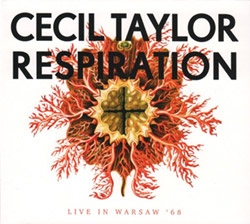
For many older listeners, hearing Cecil Taylor perform solo on a recording didn't occur until the appearance of difficult-to-come-by records like Indent (initially released on his own Unit Core label in 1973, later on Arista) or Solo on the Japanese Trio label that same year. Even ensemble recordings from the period following Conquistador! (1966), like the three volumes of Nuits de la Fondation Maeght on Shandar, weren't easy to find. So, at the time, tracing his pianistic evolution for those six or seven years was, for most, a tough task. Perhaps the clearest example of his solo direction, also not so widely distributed, was, oddly enough, Taylor's astonishing performance with the Jazz Composer's Orchestra the Michael Mantler-penned pieces, "Communications #11, Parts 1 & 2", recorded in 1968. In the ensuing decades, more solo work from the period became available, such as Praxis, recorded in July, 1968, released in 1982, but it's always a pleasure and a satisfying "piece of the puzzle" when a new recording emerges.
Respiration was recorded on October 18, 1968 at the Jazz Jamboree in Warsaw Poland. It's a 43-minute long performance, not divided into "movements" as many subsequent solo ventures were, but played straight through. Apart from other considerations, Respiration is a spectacular example of Taylor in peak form, clearly recorded, and it demands a space in the collection of any self-respecting admirer of this extraordinary musician.
Having heard many solo Taylor performances, live and on record, over the years, this listener naturally enough attempts to determine any kind of structural progression, any early establishing of motifs or attacks. There are certain similarities, especially in the general arc that he would establish, at least through documents into the 70s: an initial ferocious attack, subsiding after a while into a gentle romanticism of the sort that often seems to take cursory listeners by surprise. This occurs here some 12-13 minutes in and is lovely; echoes of Ellington are never far off during these episodes. That wavelike surging and ebbing of dynamics continues throughout, a sort of two-state situation that perhaps lacks some of the more subtle structural elements that would appear in upcoming years. Also missing (not necessarily a bad thing) are the several identifiable motifs that Taylor would employ from the mid-70s onward, melodic sequences that would be familiar to most fans, though some of his climactic cascades that would often conclude his sets can be heard in nascent form here. There's still a sense of the initial expansiveness and exploratory feelings one received from the JCOA session, recorded in June of 1968, an exhilarating quality that Taylor might have been reluctant to harness too much, allowing the music to spill out in all its fecundity, providing enormously rich soil for further investigation.
Respiration is a superb document of one of the greatest musicians of the 20th and 21st centuries.
Comments and Feedback:



More Recent Reviews, Articles, and Interviews @ The Squid's Ear...


|

